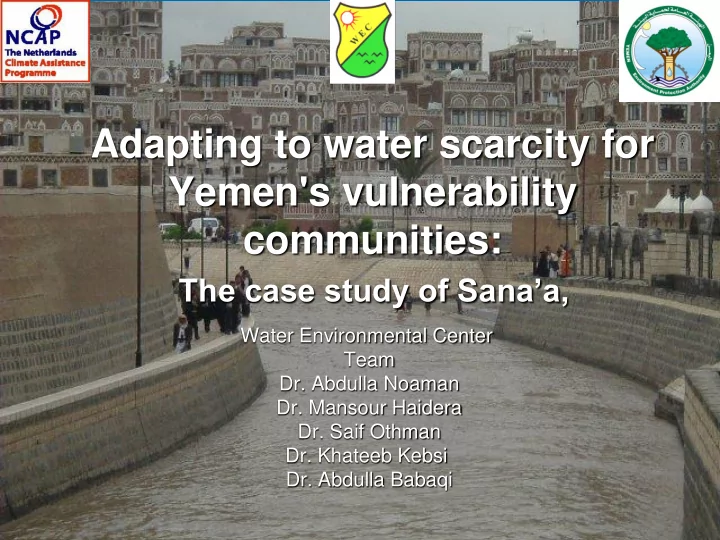

Adapting to water scarcity for Yemen's vulnerability communities: The case study of Sana’a, Water Environmental Center Team Dr. Abdulla Noaman Dr. Mansour Haidera Dr. Saif Othman Dr. Khateeb Kebsi Dr. Abdulla Babaqi 1
Project background ( Adapting to water scarcity for Yemen's vulnerability communities) Case studies, Sana’a , Aden and Sadah basins Funding from: Netherlands Climate Assistance Program Administered by: Environmental Protection Authority, Yemen Conducted by: Water and Environment Center, Sana’a University With technical assistance provided by Stockholm Environment Institute 2
Objectives Identify key water vulnerabilities under climate change with stakeholder consultation Develop scenarios exploring future water – related adaptation strategies using the Water Evaluation and Planning Software (WEAP) Prioritize adaptation strategies using stakeholder-driven Multi-Criteria Analysis (MCA) 3
Approaches and Methodology Data collection from different authorities and related ministries Rapid appraisal for participatory assessments among stakeholders. WEAP water modeling to evaluate water needs and scarcity among all sectors under a range of potential climate change scenarios. Multi Criteria Analysis (MCA) to identify a set of adaptation measures 4
Case study (Sana'a Basin) (highly urban area ) This case study was selected based on: representing a highly urban area 5 Water scarcity problems
Urban area expansion in Sana’a basin 6
Background cont.. GW abstraction in Sana'a basin Year 1970 1975 1980 1985 1990 1995 2000 2005 300 Million cubic meter 250 200 150 100 50 0 GWL Recharge to the GW GW abstraction Results: rapidly depleting aquifers and more frequent water conflicts due to growing competition for water. 7
Rainfall trend for Sana’a 8
The WEAP model of the Sana’a basin 9
Sub-structure of each sub-basin 10
The headflow/rainfed catchment nodes… 11
The irrigated area catchment nodes… 12
Simulation of hydrologic processes in the catchments… 13
The reference scenarios is not able to create sustainable use of the all demand sites…. 14
Scenarios explore 6 different adaptation strategies… 15
Scenario 1 : Indigenous improved Wadi use unmet demand for all demand sites with scenario 1 compare to reference 16
Scenario 1 : Indigenous improved Wadi use Groundwater storage for all demand sites with scenario 1 compare to reference 17
Replacing Qat with wheat production…. 18
Qat (Cathula edulis) has become a very large part of the economy - some estimate as much as 25% of GDP, 16% of employment and 30% of water use. 19
Differences in crop coefficients are the driver of this scenario…. In this scenario, the monthly crop coefficient values for wheat versus qat are the key variables that drive the difference in water demand 20
Yearly water demand for Qat versus wheat in Wadi A Sir…. 21
Replacing Qat with wheat results in less GW drawdown…. 22
Any one of the strategies alone is not enough to create sustainable use of the Central Plains aquifer…. 23
…..and for all aquifers 24
But when the effects of scenarios are added via ‘inheritance’…. 25
Adding effects of strategies approaches sustainability for Central Plains aquifer…. 26
Possible future climate scenarios also analyzed…. ‘OSU Core’ climate scenario is expected climate change: + 2 degrees C And +5% rainfall by 2050 ‘UKHI dry’ climate scenario is worst case climate change: + 2 degrees C And -20% rainfall by 2050 27
Hydrology model in WEAP explicitly simulates climate effects on crop water demands…. 28
Climate has only small effect on groundwater volume…. 29
Consultations with Farmers and Decisions makers The main aim was to discuss their concerns regarding issues of water scarcity as well as to assess their willingness to participate and be 30 committed in implementing the project activities (adapted strategy).
Identify a set of adaptation measures using MCA 31
Implement one adaptation measure proposed location of check dam in Wadi Asser 32
Examples of Adaptation) (Traditional Water Harvesting Techniques) Rehabilitation of Terraces ,Cisterns and ponds and dikes) 33
Terraces after the rainfall 34
35
Traditional ponds and cisterns 36
37
Traditional Cisterns greater capacity upward and easy access, Local material sediment trap Source: SFD 38
Traditional subsurface cisterns in rural areas Source: SFD 39
Underground reservoir in mountainous area Source: SFD 40
41
42
43
Conclusion Increase knowledge and information on the vulnerability of the water resources The need to emphasize awareness among stakeholders and decision makers Mainstreaming Climate Change in all governmental development plans and programs Special program on the issues of Climate Change in various governmental offices 44
Thanks for your attentions 45
Recommend
More recommend